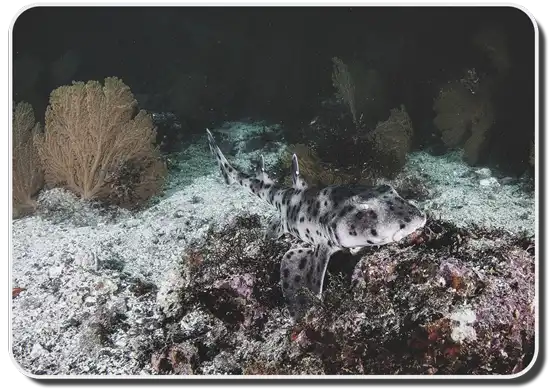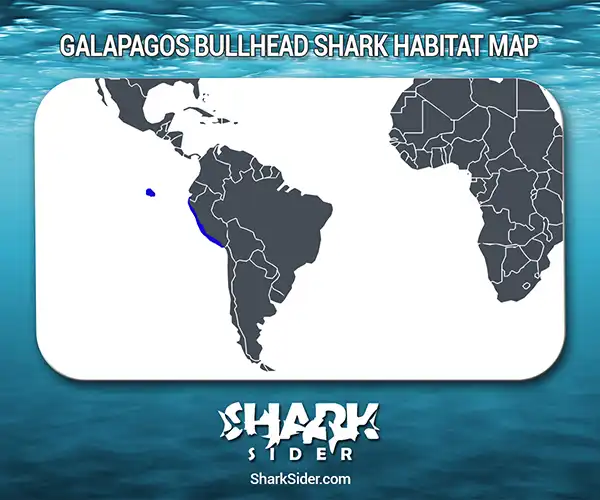Despite its unmistakable appearance, little is known about the life and ecology of the Galapagos Bullhead Shark (Heterodontus quoyi). This tropical / warm-temperate species is alternately called the Peruvian horn shark. It belongs to the Heterodontidae (Bullhead and Horn Sharks), a family of small sharks that dates back to the Jurassic period. It can grow up to 1.07 m (3.6 ft) long.

A large head, snub snout, and dark spotting on its greyish-brown skin give this fish the look of bizarre, skinny cross between a leopard and a pig. Relatively large pectoral fins add to its distinct look and enable this shark to crawl along the ocean floor.
Galapagos Bullhead Shark Facts
The genus name of this creature tells you something about how it eats. Heterodontus is Latin for “different teeth”. Like its close relative, California’s Horn Shark (H. francisci), the Galapagos Bullhead has two types of teeth. The small front teeth are hooked, for grabbing prey. The side teeth are flat, perfect for cracking and grinding shells.
The two small dorsal fins have a sharp spine that helps to deter predators. However these don’t prevent the species from being munched frequently by the much larger, aggressive Tiger Shark.
Habitat and Range
Map Of The Galapagos Bullhead Shark’s Habitat

The Galapagos Bullhead Shark lives in the Pacific southeast, near and south of the equator from 0° to 10° S latitude. As told by its name, this shark is found in the region of the Galapagos Islands. Yet funnily enough, it is not common within the archipelago. The species is quite sedentary, and may be endemic (native and restricted to) very small areas.
This species also occupies waters off the coast and islands of Peru. The Galapagos and Peruvian populations are distinct, and some authors even suggest they may be different species.
The preferred habitat of this species is sandy and rocky areas inshore, and coral reefs. It prefers waters between 3 and 30 m deep (10 to 10 ft), where it is commonly observed resting on rocky ledges. Around the Galapagos Islands this shark is associated with cold waters, in areas where upwellings of water are strong.
Feeding Behavior
This shark is active at night, when it forages along the seabed for shellfish, crabs, and small invertebrates. Once the prey is crushed, the Bullhead can eat the soft flesh and regurgitate the hard shells.
Breeding
The shark embryos are protected within tough, spiral-shaped eggs. This shape enables them to be wedged into rock crevices for protection from predators. The newborn sharks are about 17 cm (6.7″) long. They reach sexual maturity once they have reached roughly triple that length.
Humans and Conservation
This is a harmless species when encountered by scuba divers. It is docile, non-aggressive and a weak swimmer – in fact it typically rests motionless on the sea bottom.
It is not targeted by commercial fisheries, but like most sharks it is likely taken as a Bycatch of inshore fisheries. Because its populations are so small, this species could be vulnerable to local-scale, negative events. The Galapagos population is somewhat protected within the Galapagos Marine Reserve, where fishing is banned.
But one potential environmental threat to this species extends past such park boundaries: that is climate change. Global warming can impact sharks because a rise in sea temperature leads to a lower level of oxygen in the water. This can also cause changes in the salt concentration of coastal waters due to more runoff. Temperature changes influence shark behavior, because many species feed in warmer waters and rest in cooler waters. This can in turn alter shark distributions, meaning where we find each species.
There are also serious “indirect effects” of climate change on sharks, such as loss of prime nursery habitat in coastal areas, and a loss of food resources because of changes in the ocean’s movements.
What does all this mean for the Galapagos Bullhead Shark? Even though this critter lives near the equator, it depends on cold upwellings of sea water around the Galapagos Islands. That means that changes in water temperature would have a direct impact on the life of this uncommon species.
The International Union for Conservation of Nature (IUCN) classifies this species as “Data Deficient” on its Red List of Threatened Species. That means that we need shark researchers to find out more information about this fascinating creature!
Written By: Kara Lefevre
Sources
Hearn A, Ketchum J & Klimley AP. Vulnerability of top predators to climate change and adaptations for coastal and pelagic ecosystems: sharks, a case study (Discussion document). University of California, Davis. (migramar.org)
IUCN Red List: Kyne PM, Rivera F & Leandro L (2004). Heterodontus quoyi. In: IUCN 2012. IUCN Red List of Threatened Species. Version 2012.2.
